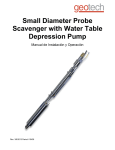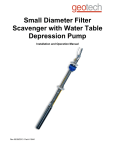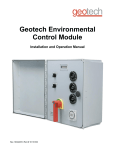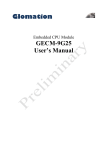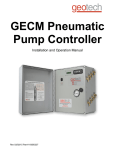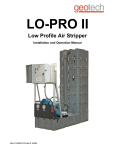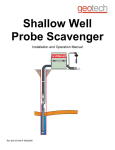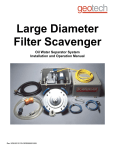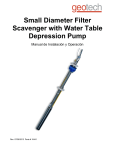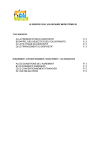Download Geotech Small Diameter Probe Scavenger with Water Table
Transcript
Small Diameter Probe Scavenger with Water Table Depression Pump Installation and Operation Manual Rev 2/28/2013 Part # 10438 TABLE OF CONTENTS Section 1: System Description …………………………..…………….………………………………… Function and Theory …………………………………………………………………………………. System Components ………………………………………………………………………………… Section 2: System Installation ……………………………..…………….………………………………. Section 3: System Operation …………………………………….……………………………………… Section 4: System Maintenance …………………………………………………………………………. Section 5: System Troubleshooting ……………………………..……………………………………… Section 6: System Specifications ……………………………………………………………………….. Section 7: Winch Assembly and Operation …………...............………….…………………………… Section 8: Replacement Parts and Accessories ……………………………………………………… Appendix A: Submersible Water Pumps …………….…………………………………………………. Appendix B: Decontamination Procedures ……………….……………………………………………. Warranty, Equipment Return, and Repair ……………………….……………………………….…….. 1 3 3 4 11 20 22 24 28 30 32 36 41 44 DOCUMENTATION CONVENTIONS This manual uses the following conventions to present information: An exclamation point icon indicates a WARNING of a situation or condition that could lead to personal injury or death. You should not proceed until you read and thoroughly understand the WARNING message. WARNING A raised hand icon indicates CAUTION information that relates to a situation or condition that could lead to equipment malfunction or damage. You should not proceed until you read and thoroughly understand the CAUTION message. CAUTION A note icon indicates NOTE information. Notes provide additional or supplementary information about an activity or concept. NOTE READ THE FOLLOWING CAUTIONS & SUGGESTIONS BEFORE PROCEEDING The Small Diameter Probe Scavenger is a sophisticated piece of equipment which must be installed, operated and maintained according to the procedures described in the system manual. Failure to follow these procedures or to observe the cautions included in this manual, may result in personal injury and will void the Standard Equipment Limited Warranty. Installation Do not deploy the PSCAV until the well has been developed by qualified personnel. Silt and grit can damage the water pump and degrade its performance. Before deploying the system in the well, briefly test the water pump by turning the control switch to HAND. Do not run the water pump dry for more than 5 seconds at a time. Mount your GECM (or other control panel) under cover and in a location where it will never be submerged in water. All system wiring is to be carried out by a qualified electrician. For systems using a GECM or other control panel with an integrated Tankfull probe, the PSCAV system will not run when the Tankfull probe is cut or disconnected. 2 Section 1: System Description Function and Theory The Small Diameter Probe Scavenger (PSCAV), built with a Water Table Depression Pump (WTDP), is an automatic pumping system designed to simultaneously recover water and hydrocarbons. A specially designed probe differentiates between hydrocarbons and water, allowing for retrieval of virtually 100% water-free oil. The water pump creates a “cone of depression” in the well, drawing in the hydrocarbons that contaminate the surrounding groundwater. The product pump then recovers the hydrocarbons floating on the water and pumps them into a product recovery tank. When the tank becomes full, an optional Tankfull probe can be used to shut down the product pump to prevent overflow. The PSCAV can be built for product only applications where a separate WTDP pump may be installed or when there isn’t a need for a water pump. Figure 1-1 is an example of both units (the water pump and motor is not shown attached to the WTDP ready unit in this diagram). Figure 1-1 – Small Diameter Probe Scavenger with Water Table Depression Pump. 3 When used with the optional Geotech Environmental Control Module (GECM), the standard PSCAV system will consist of a downwell assembly that includes a product pump, an intake assembly (optional), a product/water probe (optional), a Tankfull probe (optional), and a water pump (optional). Section 8 contains a breakdown diagram of a standard PSCAV unit followed by a list of definitions and part numbers. An extended list of optional components is also included. Major system components are described on the following pages. PSCAVs are built for either Product only use or as WTDP ready (with water pump and motor). In either case, throughout the rest of this manual, the term PSCAV will be used to describe the system in general. PSCAV Modifications for Diverse Environments For well environments that could cause premature wear to various PSCAV components, Geotech can provide limited upgrades to a standard PSCAV to increase the life of the unit. For example, a PSCAV unit modified for use with chlorinated LNAPL applications will have the following parts replaced: Standard part Cable assembly Product/water Probe Kevlar gear set (product pump) PTFE check valve Upgraded part ETFE coated cable Large diameter probes with PTFE coated cables and Stainless steel floats Polyamide gear set SS check valve These upgrades can provide longer life to the operational parts on the PSCAV. Discuss the possible need for any modifications to your PSCAV system with your Geotech Sales Representative. System Components Product Pump The Geotech product pump (with motor) is a magnetically coupled gear pump system that operates on 12VDC. The product pump turns on and off in response to signals sent to the GECM by an attached conductivity/density probe and a second separate Tankfull probe. Descriptions of these probes can be found later in this section. The following chart represents a Gallons per Minute (GPM) per PSI (Pounds per Square Inch) average for the product pump. However, flow results can vary for a variety of reasons, i.e. new gear set, worn gear set, worn motor/bushings, line loss or low voltage to product pump motor. An example of the Product Pump performance curve is shown in Figure 1-2. PSI Range GPM/LPM Flow Rate Amps* Open flow .77 / 2.9 2.30 20 PSI (1.4 bar) .72 / 2.7 3.00 40 PSI (2.7 bar) .70 / 2.6 3.70 60 PSI (4 bar) .66 / 2.5 4.45 65 PSI (4.5 bar) (a functional product pump/motor will stay under 5 amps at 65 PSI / 4.5 bar) 80 PSI (5.5 bar) .61 / 2.3 5.10 100 PSI (6.9 bar) (a product pump/motor will decouple between 95 PSI and 105 PSI / 6.9 bar) *Test results were obtained using a Geotech Power Supply with an average output of 14.5VDC. 4 The product pump is designed to decouple between 95 PSI (6.5 bar) and 105 PSI (7.2 bar) (or greater). 90 (6.2 bar) to 95 PSI (6.5 bar) is therefore the maximum pressure obtainable depending on the viscosity of the hydrocarbons being pumped. Factors that may reduce decoupling pressure (and therefore reduce maximum output pressure) include temperatures above 75°F (24°C), high fluid viscosities, abrasive fluids and pump wear. Once decoupling has occurred, the pump and motor can be recoupled by completely stopping and then restarting the unit. Figure 1-2-1 – Product Pump performance curve (gallons per hour/PSI) Figure 1-2-2 – Product Pump performance curve (liters per hour/BAR) 5 System Accessories The following accessories must be ordered separately from the basic PSCAV system. Refer to Section 6 of this manual for a listing of available accessories for your PSCAV system. Water Pump A set of HI and LO water sensors are located on the downwell probe (see Figure 1-3). These sensors indicate the water level during installation and operation. When the water level becomes too high, a signal is sent to the GECM to turn on the water pump (for WTDP ready systems.) The water pump will automatically lower the cone of depression in the well and shut off when the water float reaches the lower sensor. This function keeps the opening on the intake assembly as close to the product layer as possible. However, it may be necessary to re-adjust the PSCAV position within the well also. Water pumps are available with 2-wire or 3-wire motors and range in power from 1/3 to 20 horsepower. 2-wire motors are available in single phase only and feature built-in start components and thermal overload protection. 3wire motors (through 1HP) include built-in thermal overload protection. 3 phase, deep well submersible pump motors, which require an external start component, can come with either an external start box or designated motor starter (installed within the GECM). Start boxes and motor starters are supplied by Geotech as an option. Most motor/pump scenarios, including multiple pumps, can be controlled by one GECM with the appropriate motor starter(s) installed. Refer to Appendix A for a list of water pumps available from Geotech. Intake Assembly The intake assembly is designed with an outer 60 mesh screen and a removeable inner 100 mesh screen. Together they allow product or water to be captured and pumped to the surface via the product pump. When used in conjunction with the downwell probe assembly, the PSCAV system can be designated for product only collection from the surface of water within a well. It is recommended that you use the PSCAV system to collect product that is acceptable to the internal 100 mesh screen of the intake. The Viscosity Chart (Figure 6-1) lists all of the products easily recovered with this intake assembly technology. If well conditions require something more aggressive, then contact your Geotech Sales Representative. The intake assembly comes with a unique set of modified worm clamps which allow the intake and probe to be easily attached together on the PSCAV center pipe. A 6” (15 cm) piece of 3/8” poly tubing and brass compression fittings complete the connection. Figure 1-3 shows an example of the intake assembly along with a standard probe. The stop collar that is just above the Water HI switch must be placed horizontally centered to the weld of the intake screen to maximize product intake from the water surface. 6 Downwell Probe The product and water pumps cycle on and off in response to signals sent to the control panel by a level sensing probe. Figure 1-3 shows an example of a standard product and water probe which is commonly used with either a WTDP ready PSCAV or a PSCAV with a separate water pump. The probe, when properly attached to the optional intake assembly, uses float actuated switches to assure that the product pump delivers hydrocarbon only. The Product float must be suspended in hydrocarbon for the product pump to run. Once the Product float reaches the upper switch, the product pump will turn on until the float magnet falls back below the switch. This assures that the product pump only runs when sufficient hydrocarbons are present in the well. The next float (HI/LO Water) is buoyant in water only and disables the product pump when it reaches the Water High switch. This prevents the product pump from running if the hydrocarbon/water interface in the well rises to the level of the product pump intake. Figure 1-3 – Intake assembly with downwell probe. 7 The water pump is controlled by the Water HI/LO and Override floats. The water pump turns on when the Water HI/LO float rises to the top of its travel. The pump continues to run until the float falls to the bottom of its travel. If a probe fault should cause the pump to continue running, the Override float will fall and shut off the pump. The stop collar that is just above the Water HI switch must be placed horizontally centered to the weld of the intake screen to maximize product intake from the water surface. All probe wiring is rated Intrinsically Safe for Class 1, Div. 1, Group D hazardous locations. Tankfull Probe A second probe is used to shut off the product pump if the product recovery tank becomes full. This tankfull override probe (Figure 1-4), is a float actuated level sensor installed in the top of the recovery tank. When used with a GECM or other control panel, the PSCAV system will shut down whenever the Tankfull probe is disconnected or the line is cut. Figure 1-4 – Tankfull Probe Assembly 8 Junction Boxes To facilitate the wiring of the PSCAV system, Geotech offers ready to install power and signal junction boxes (Figure 1-5). The optional junction boxes contain terminal strips that allow the PSCAV cable assembly and downwell probe cable to be joined to customer installed, conduit enclosed wire runs from the well head. Explosion proof junction boxes can be provided (as shown in Figure 1-5, items A and C) or terminal connections can be housed within a NEMA 4 junction box (item B). Figure 2-1 contains a generic example of a common site installation, showing power and signal junction box placement. Figure 1-5 – Junction boxes available for use with the PSCAV system. (A) Explosion proof power junction box. (B) NEMA 4 signal junction box. (C) Explosion proof junction box with receptacle. Refer to the System Accessories section for part numbers. Product Pump 12VDC Power Supply Power Supply’s are used to operate the 12VDC product pump motors built into the PSCAV system. An 115VAC or 230VAC Power Supply is available from Geotech. Power requirements are dependent on either the main power or an installed transformer within the GECM. A Power Supply is designed to receive two power leads from the GECM; HOT and NEUTRAL for 115VAC, or two HOT leads for single phase 230VAC. The voltage is then converted to 12VDC (with an average output of 14.5VDC) for product pump operation. Figure 1-6 shows an example of a 230VAC to 12VDC Power Supply panel. 9 Each panel comes housed in a NEMA 4 enclosure with labeled terminal strips. A wiring diagram can be found on the inside cover of the enclosure. Power Supplies should be installed as near to the well as possible to reduce DC line loss between it and the product pump. Two AC power wires will then run from a relay or terminal strip within the GECM to terminal strip TB1 on the Power Supply panel. Single phase motors can be wired through the Power Supply box or directly to a motor starter within the GECM. Three phase water pump motors are wired directly to a designated motor starter within the GECM, bypassing the Power Supply. Figure 1-6 – Example of the components to a 230VAC to 12VDC power supply. Hoses 100’ (30 m) of 3/8” nylon hose (for attachment to the discharge tube fitting) is provided with each PSCAV system built. Additional discharge hoses and fittings supporting both product and water pump use can be obtained from Geotech also. Additional Accessories A variety of options and accessories are available to the PSCAV system, including globe valves and flow meters. Refer to the section on System Accessories for a list of parts provided to the PSCAV system. A larger selection of accessories can be found in the Geotech catalog. 10 Section 2: System Installation The PSCAV system must be installed, operated and maintained according to the procedures described in this manual. Failure to follow these procedures, or to observe the Warnings and Cautions included in this manual, may result in personal injury and will void the Standard Equipment Limited Warranty. Do not deploy any pumps until the well has been developed by qualified personnel. Excessive silt and grit can clog the intake float cartridge or damage the water pump, degrading their performance. Never run the product or water pump dry for more than 5 seconds at a time. Position the water pump so that the intake is no closer than 1’ (30cm) from the bottom of the well. Inspection Inspect the SDFS unit and accessories upon arrival. If any items are missing or damaged, make note of this on the shipping papers and immediately notify your Sales Representative at Geotech. Also, in preparation for installation, remove any shipping straps and cable ties from around the intake float cartridge prior to deployment. System Wiring Throughout the wiring procedures described below, refer to the site installation drawing in Figure 2-1, the various wiring diagrams within this section, and to the separate Field Wiring Diagram provided with your GECM control panel. All wiring must be carried out by a qualified electrician and be in accordance with the state and local codes. Conduit runs must conform to Article 501-5 of the 1990 National Electrical Code (NEC). Install GECM In preparation for installation, mount the GECM control module under cover to protect the unit from the elements. Power must be disconnected and locked out at the panel or services before any installation procedures are attempted. Wiring Product and Water Pump Connections The PSCAV system can be ordered with a variety of Grundfos water pumps attached. These pumps are operated with single and three phase motors. Product pumps are available only in 12VDC and are built and installed internally to the PSCAV by Geotech. If applicable, refer to the GECM Field Wiring Diagram and to the wiring diagrams on the following pages for installation and wiring instructions specific to your system. Do not run any power wires within 2 inches (5 cm) of intrinsically safe (IS) wires or terminals. Reference NEC Article 508 for relevant codes. When wiring to a GECM control panel run the pump power wires through the bottom of the enclosure and attach them to the WATER PUMP and PRODUCT PUMP POWER OUT terminals. Attach the ground wire to the chassis grounding lug next to the terminal block. Check tightness of terminal screws. 11 Figure 2-1 – A WTDP ready PSCAV deployed with the optional GECM, power supply, Tankfull probe, and explosion proof accessories. Wiring a Single Phase 115 or 230VAC PSCAV with Water Pump and 12VDC Product Pump Motors Wire the water pump motor leads for a single phase, 115 or 230VAC motor through a wellhead junction box (optional) and attach the leads to labeled terminal strip TB2 within a 115 or 230VAC Power Supply. Single phase motor leads from a WTDP ready PSCAV will be black, red, and yellow (ground) and will be connected color for color to positions 1, 2, and 3 on TB2. Wire the GECM to the Power Supply by attaching a pair of HOT leads to positions 1 and 2 on TB1 (AC power to be converted to 12VDC for the product pump), and a pair of HOT leads to positions 3 and 4 on TB1 (115 or 230VAC single phase power to run the water pump motor). These leads will generally come from labeled relays or terminal strips built onto the back panel of the GECM. Attach a ground wire from a designated ground lug to position 5 on TB1 (yellow/ground). Figures 2-2 AND 2-3 show examples of 115 and 230VAC WTDP ready PSCAV wiring diagrams. Terminal positions are labeled on all GECM back panels and on all Power Supply panels provided by Geotech. See the GECM Field Wiring Diagram and the Power Supply diagram for additional wiring instructions. Alternatively, the water pump power leads can also be run directly to a separate motor starter within the GECM, bypassing the Power Supply enclosure all together. 12 Figure 2-2 – Wiring the 115VAC 2-Wire Water Pump and the 12VDC Product Pump Motors. Figure 2-3 – Wiring the 230VAC 2-Wire Water Pump and the 12VDC Product Pump Motors 13 Wiring a Three Phase PSCAV with Water Pump and 12VDC Product Pump Motors Wire the water pump motor leads for a three phase, 230VAC motor through a wellhead junction box (optional) and attach the leads to T1, T2 and T3 of an appropriate start box or to a motor starter labeled WTDP within the GECM. Wire the GECM to a 230VAC Power Supply by attaching a pair of HOT leads to positions 1 and 2 on TB1 (AC power to be converted to 12VDC for the product pump). These leads will generally come from a labeled relay or terminal strip built onto the back panel of the GECM. Figure 2-4 shows an example of a 230VAC three phase WTDP ready PSCAV wiring diagram. Terminal positions are labeled on all GECM back panels and on all Power Supply panels provided by Geotech. See the GECM Field Wiring Diagram and the Power Supply diagram for additional wiring instructions. An 115VAC Power Supply can also be used if the GECM has an appropriate transformer installed. Figure 2-4 – Wiring the 3-Phase Water Pump and the 12VDC Product Pump Motors. 14 Wiring a 12VDC Product Pump (w/o Water Pump) Wire the product pump motor leads from a PSCAV system through a wellhead junction box (optional) and attach the leads to positions 4 (blue/common) and 5 (orange/ground) on terminal strip TB2 within a 115 or 230VAC Power Supply enclosure. Wire the GECM to the Power Supply by attaching a pair of HOT leads to positions 1 and 2 on TB1 (AC power to be converted to 12VDC for the product pump). These leads will generally come from labeled relays or terminal strips built onto the back panel of the GECM. Attach a ground wire from a designated ground lug to position 5 on TB1 (yellow/ground). Figure 2-5 shows an example of a 115VAC PSCAV wiring diagram for a product pump only. Figure 2-5 – Wiring for Product Only pump motor. Wire Downwell Probe Run the probe cable leads to a wellhead junction box and then to the GECM control panel. Run the cable through the access port on the side of the enclosure and attach its leads to the terminals on the PCB as shown on the GECM Field Wiring Diagram. Small Diameter Probe (standard - mounted to the PSCAV) Float/function Wires Status Product Water High Water Low Water Override Blue/Red Blue/White Blue/Black Green/Orange ground (or casing) Normally Open (NO) NO Normally Closed (NC) (held open by float) NC (held open by float) 15 Large Diameter Product Probe (mounted to the PSCAV) Float/function Wires Status Product Water High Water Low Water Present (continuity function) Green/Orange Blue & Yellow/White Blue & Yellow/Black Blue & Yellow/ ground (or casing) NO NO NC (held open by float) Large Diameter Water Probe (shipped separately) Float/function Wires Status Water High Water Low Water Override Water Present (continuity function) Blue & Yellow/White Blue & Yellow/Black Green/Orange Blue & Yellow/ ground (or casing) NO NC NC Figure 2-6 – Wiring a standard PSCAV Downwell Probe to a GECM (requires Field Wiring Diagram.) 16 Wire Tankfull Probe After mounting the Tankfull probe in the product recovery tank, run the probe cable through the access port on the upper side of the GECM enclosure and attach the leads to a designated IS terminal strip on the GECM PCB (as shown in the GECM Field Wiring Diagram). Refer to Figure 2-7 for additional wiring details. Figure 2-7 – Wiring a Tankfull probe to the GECM (requires Field Wiring Diagram.) 17 System Pre-check If you have ordered an Intake Assembly and Downwell Probe, these parts will already be attached to the PSCAV center pipe (as shown in Figure 1-1). Confirm that the Intake Assembly and probe are firmly mounted to the unit and that the stop collar above the HI Water switch (Figure 1-3) is horizontally centered to the weld on the intake screen. This will maximize product intake from the water surface. Before deploying a PSCAV system into the well, carry out the following unit preparation procedures. On Product Only Systems Fill the pump water jacket with clean water by turning the PSCAV assembly upside down and removing the plug at the bottom of the water jacket. Check all wiring. On product only applications the orange and green wires will not be used or wired to the GECM. For WTDP ready PSCAV, verify exposed wiring to the water pump/motor are zip tied and out of the way from catching on the walls of the well. System Deployment 1. Attach one end of the 3/8” nylon product hose to the compression fitting on the checkvalve (see Figure 28.) 2. Attach a winch cable to the eyebolt of the PSCAV system and carefully lower the assembly into the well. As you place the unit into position, ensure that the water pump intake (WTDP applications) is no closer than 1’ (30 cm) from the bottom of the well. This will prevent debris from entering the pump intake which can cause premature wear to the pump impellers. Under no condition should a PSCAV system be suspended down the well by its power cord or discharge hoses. 2. Confirm that the output hose of the water pump is connected to suitable collection point or proper runoff. Check local regulations. 3. Run the 3/8” nylon product discharge hose to the product recovery tank. 4. Set both the product and water pumps to OFF. Apply power to the GECM.This will allow you to observe the control panel display for float positions. See page 21 for display information. 5. Adjust the position of the PSCAV assembly in the well until the product float is suspended in product. 6. GECM display will read water and product levels. Refer to the GECM User Manual or Section 3 of this manual for display definitions. You may need to run the water pump in HAND until a stable “cone of depression” within the water table has been established. When the pump assembly passes through the hydrocarbon/water interface, fluid displacement will artificially raise the level of the interface in the well. This condition can persist for up to 48 hours depending upon the permeability of the earth surrounding the well. Readjustment of the PSCAV system level as a whole may be required. 18 Figure 2-8 – Location of Discharge Hose 19 Section 3: System Operation System Startup Verify product discharge line is securely connected to the product recovery containment vessel. Before starting the pump, read your GECM control panel manual and become thoroughly familiar with all panel controls and indicators. Proceed as follows to start the system. 1. Visually inspect all power wire terminations are tied down and no loose wire ends are left unterminated. 2. System pre-check and deployment are complete. 3. Turn all Hand-Off-Auto switches to OFF. 4. Apply power to system through on-site breaker or integrated disconnect. 5. Open the water pump discharge valve completely by turning it counter-clockwise. 6. Turn the WATER PUMP CONTROL switch to AUTO. The water pump side of the system should be purged if free phase hydrocarbon is present in the well at deployment. To do this, place the output hose in a suitable container and run the pump on HAND until the water runs clear. Dispose of purged hydrocarbon according to local codes. 7. With the water pump running on AUTO, establish a pumping level and throttle down the outflow by adjusting the discharge valve. Reduce the rate of pump cycling as far as possible without going below the minimum flow rate recommended by the pump’s manufacturer. Ideally, the pump should be valved to approach continuous operation while maintaining the desired water level. Adjust the position of the downwell assembly as explained in Section 2. 8. Start the product pump by turning the PRODUCT PUMP CONTROL switch to AUTO. If the product float is up and H2O-Hi is not, product pump will start. Once startup has been achieved, the PSCAV system should function automatically. Refer to the GECM User Manual for details of control panel operation. 20 GECM Display Messages for the PSCAV The following display messages are common to the operation of a WTDP ready PSCAV system. PSCAV Displays – Line 1 messages: HAND:Px H2Ox ORx AUTO:Px H2Ox ORx AUTO: TANKFULL AUTO: OVERRIDE AUTO:PROBE FAULT (condition) (fault) (fault) Line 2 messages: PRODnnnn H2Onnnn Where x = H (high), M (middle), or L (low) nnnn = ON, OFF or HAND The “Px H20x ORx” portion of the display is representative of the fluid as read by the float positions along the probe. “Px” represents the product level within the reservoir, “H2Ox” represents the position of the water float, “ORx” represents the override float. Multiple PSCAV Systems Line 1 messages: PSCAV SYSTEM # PSCV#: TANKFULL PSCV#: OVERRIDE PSCV#:PROBEFAULT (condition) (fault) (fault) Line 2 messages: PRODnnnn H2Onnnn Where # = 1, 2, 3 or 4 (PSCAV number) nnnn = ON, OFF or HAND Additional Messages for Multiple PSCAV Systems: PSCAV #: LEVELS OVERRIDE (fault) PSCAV #: LEVELS PROBE FAULT (fault) PSCAV #: LEVELS Px H2Ox ORx Where # = 1, 2, 3 or 4 (PSCAV number) x = H (high), M (middle), or L (low) 21 Section 4: System Maintenance Clean Intake Strainer The intake is a two stage strainer that can easily be disassembled for cleaning. This should be done periodically to insure that the product pump will not run dry. Time elapsed between cleanings will depend upon well conditions. In the event that frequent strainer cleanings are not considered a cost effective maintenance procedure, the inner 100 mesh strainer can be removed. By using a ½” MPT x ¼” FPT threaded reducer bushing, the 60 mesh outer strainer can be used alone. However, the long term effects on the product pump must be considered when the 100 mesh inner strainer is not used. Pumping damaging debris will quickly diminish the performance of the pump gears, lead to the need for pump repair or replacement, and increase the overall down time of the system. With proper usage and servicing, the two stage intake strainer should substantially increase the life of the pump. It is recommended that you use the PSCAV system to collect product that is acceptable to the internal 100 mesh screen of the intake (see also the Viscosity Chart in Figure 6-1.) If well conditions require something more aggressive, then contact your Geotech Sales Representative. Since the downwell pump assembly must be removed from the well to perform maintenance on the intake strainer, such occasions should be used to carry out a general inspection of the entire assembly. It is particularly important that the flexible product hose be carefully checked. This hose should be replaced if leaks or major kinks are discovered. Clean Probes It is essential that the probe shafts and floats be cleaned on a regular basis. Use phosphate detergent, warm water and a soft brush. The required frequency of cleanings is highly site specific and must be determined by the user. Failure to clean the probe will result in fouling that could cause system malfunction. Water Pump Maintenance The following is a schedule of water pump maintenance. Water Table Depression Pump System Frequency of Maintenance Tasks / Quarterly Calendar Week Task 1 2 3 4 5 6 7 8 9 10 11 12 Check flow rate to ensure minimum cycling frequency ● ● ● ● ● ● ● ● ● ● ● ● Remove cover from probe and clean floats/conductivity sensors ● ● ● ● ● ● ● ● ● ● ● ● Check start box for moisture accumulation Take current draw readings and compare with motor specification ● ● ● Inspect hoses and wires for cracks, cuts, and abrasions ● ● ● ● ● ● ● 22 Backup Checkvalve It is recommended that an alternate checkvalve be installed in the event of a primary checkvalve failure. Installation can be carried out without removing the downwell pump assembly from the well. The backup checkvalve will consist of a white Acetal valve, two stainless steel reducer bushings and two brass compression fittings. This specific valve is not interchangeable with the checkvalve installed on the unit and is mounted as a back up only. Contact your Geotech Sales Representative for these parts when a backup checkvalve is needed. To install an inline checkvalve 1. 2. 3. 4. 5. Cut the nylon discharge line at a convenient accessible location next to the well head. Thread the stainless steel reducer bushings into the valve ends using PTFE tape on all male threads. Orient the valve so that the arrow points in the direction of fluid flow. Thread the compression fittings into the reducer bushing using PTFE tape. Insert the cut ends of the discharge line into the compression fittings and tighten. Figure 4-1 – Parts configuration for standard and back up checkvalves. 23 Section 5: System Troubleshooting These procedures are meant to be carried out by personnel qualified to work on electrical circuitry. If in doubt, obtain the services of a qualified electrician. Getting Help Read the entire manual and become thoroughly familiar with all system components before intitiating any of the following troubleshooting procedures. If the troubleshooting procedures in this section indicate a component failure, prepare a written list of all problems encountered while operating the equipment, then call Geotech Environmental Equipment for assistance. Service Locations Geotech Field Service personnel are trained on all aspects of the equipment and are dedicated to helping you maximize the efficiency and cost effectiveness of your PSCAV system. For technical support call our Geotech Service office. Geotech Environmental Equipment, Inc. th 2650 East 40 Avenue Denver, CO 80205 Toll Free Phone: (800) 833-7958 Commercial Phone: (303) 320-4764 Fax: (303) 322-7242 www.geotechenv.com Troubleshooting Procedures In the process of troubleshooting, it may be necessary to open the GECM control panel. In such cases, always disconnect the power before proceeding. Avoid shorting any power to the PCB or PCB cover. Since all probe wiring is rated Intrinsically Safe, probe connectors may be disconnected from their receptacles without disconnecting the power. Troubleshooting the PSCAV is primarily a matter of checking the function of the intake strainer and the probes. The GECM is designed to be maintenance free. The water pump/motor is factory sealed with no field replaceable parts. Before proceeding with this section refer to the troubleshooting section of your GECM User Manual. Possible malfunctions are listed as follows: 24 Problem: Water pump running but no water delivered Cause: 1. 2. 3. 4. 5. Discharge valve closed. Discharge hose kinked or blocked. Pump motor running backwards (3 phase motors only). Debris clogging intake. Cut wire. Remedy: 1. 2. 3. 4. Open valve. Locate blockage and clear. Reverse any two legs at the connection between the pump power cord and the control panel. Pull unit and inspect all wiring. Problem: Product pump will not run on AUTO, runs dry on HAND Cause: 1. The intake is plugged with debris. 2. The product pump is mounted too low with respect to the intake. 3. The pump has decoupled from the motor. Remedy: 1. Remove the pump assembly from the well, disassemble the intake and clean the 100 mesh intake screen. 2. Remove the pump assembly from the well and confirm that the HI Product switch on the Downwell Probe is positioned above the weld on the product pump intake screen (see Figure 1-3). 3. Refer to Figures 1-2-1 and 1-2-2 and confirm that the output pressure generated by your system does not exceed the decoupling pressure of the pump. Problem: Pump will not run on HAND or AUTO Remedy: 1. Confirm that power is reaching the GECM or other control panel. 2. If power is reaching the GECM, then check for a faulty Tankfull probe by unplugging its connector at the GECM and jumpering between receptacle sockets A and B. If the pump runs on HAND with the Tankfull disconnected, then the problem is most likely a faulty Tankfull probe or cable. 3. It is also possible that the recovery tank is just full, or that the float on the probe has been re-installed upside down after being cleaned. 4. If the problem is not in the GECM or Tankfull probe, then a faulty product pump/motor or cord should be suspected. Remove the pump assembly from the well, move it and the GECM to a non hazardous location and check the pump operation and its power cord. A faulty product pump/motor should be replaced. If the pump will not run after carrying out these procedures, the wiring or the pump motor itself may require repair or replacement. Call your Geotech Sales Representative for assistance. 25 Problem: Pump Runs on HAND but not on AUTO Cause: The most likely source of trouble in the AUTO mode is a probe circuit fault or a bad connection at the wellhead junction box. Remedy: 1. Use a continuity meter to check probe connections at the panel or at the terminal strip inside the wellhead junction box. If no bad connections are found, proceed as follows to determine if the probe fault is in one of the probes or in the panel’s control circuitry. 2. If the probe is faulty then call Geotech for assistance. Problem: Water Pump Runs Dry Cause: 1. Discharge valve is closed 2. Discharge hose kinked or blocked. 3. Pump motor is running backwards (3 phase motors only). Remedy: 1. Open valve. 2. Locate blockage and clear. 3. Reverse any two of the three power legs at the connection between the water pump power cord and the control panel. Problem: Product Pump Performs Poorly Cause: 1. The product pump motor is running backwards. 2. Voltage drop caused by long wire runs. 3. Product pump is worn from pumping grit and debris. Remedy: 1. Check the Field Wiring Diagram supplied with your GECM and confirm that the product pump is not wired backwards. 2. Increase gauge of pump power wires if runs are longer than approximately 100’ (30 m). 3. Remove pump from well and check gears for wear. Pressure test the pump for discharge head capability (see Figure 1-2, for pump performance curve). If gears are worn, pump head must be replaced by a Geotech technician. 26 Tankfull Probe The following applies to control panels with a Tankfull receptacle. As a safety measure, systems with an integrated Tankfull probe will shut down when the probe is disconnected or the cable is cut. A–B Normally Closed connection. Simulates that the Tankfull float is down. Pump will run. Removing the A – B jumper connection will simulate a Tankfull float up. Shuts pump off. One common problem with the Tankfull probe not working is the float being installed upside down after cleaning. Figure 5-1 – 8 pin Tankfull Probe receptacle. 27 Section 6: System Specifications Figure 6-1 - Viscosity chart and temperature 28 New PSCAV Specification Sheet System Type: ____ Product Only ____ WTDP Ready ____ ETFE Cable ____ Polyamide Gear Set Installed WTDP Power Requirements: ____ Voltage ____ Phase Downwell Probe: Y / N ____ HP ____ Hz Part No. _________________ Connector Attached: Y / N Intake Assembly: Y / N Power Supply: Y / N ____ 120V ____ 230V Winch Assembly: Y/ N ____ Standard ____ Heavy Duty Cable / Hose Lengths: Power Cord Length: ______ ft./m Discharge tubing length: ______ ft./m Serial No. _______________________ P.I.D. _______________________ ____ Product Only Inspected by: _______________________ 29 ____ WTDP Ready Section 7: Winch Assembly and Operation Winch assemblies are available for the SDFS system. Mount the winch on the well casing as shown in Figure 7-1. Attach the winch cable to the lift cable on the unit. Carefully lower the unit into the well and suspend at the desired level. The cable on a standard winch has a rated breaking strength of 2000 lb. (907 kg) using the recommended design ratio of 1 to 5. The rated break strength gives a maximum hanging weight of 400 lb. (181 kg). Because each application is different, it is impossible for Geotech to anticipate the exact hanging weight of your system. Hanging weight is the sum of pump weight, the weight of all discharge piping, and the weight of any water trapped inside the piping. Although it is unlikely that you will exceed the 400 lb. (181 kg) maximum, Geotech highly recommends that you take the time to calculate the hanging weight of your system before deployment. Use the following procedure to calculate hanging weight. 1. Weigh your pump assembly, including the intake and any attached probes. 2. The weight of the discharge piping can be calculated by weighing a sample length and multiplying by the number of feet suspended in the well. For example, 1.5” ID rubber hose weighs approximately 1 lb. (.45 kg) per foot (.3 m) . Therefore, 100’ (30 m) of this hose will weigh 100 lbs. (45 kg). 3. The weight of the water in the discharge piping can be estimated by calculating the volume of water in the piping and then converting the volume to weight as follows: Volume in gallons Volume (in³) = x [inside radius of pipe (in)]² x [length of pipe (in)] Gallons = 0.00433 x Volume (in³) 1 Gallon (water) = 8.325 lbs Weight of Water (lbs) = 8.325 x Gallons Volume in liters Volume (cm³) = x [inside radius of pipe (cm)]² x [length of pipe (cm)] Liters = 0.001 x Volume (cm³) 1 Liter (water) = 1 kg Weight of Water (kg) = Total number Liters 4. Find the sum of the pump weight, piping weight, and water weight. This sum will provide a close approximation of the total hanging weight. If the total hanging weight approaches or exceeds 400 lbs. (181 kg), then contact Geotech to discuss an optional winch cable with an increased break strength rating. 30 Figure 7-1 – Standard winch assembly attached to well head. 31 Section 8: Replacement Parts and Accessories This section lists standard components and optional accessories supporting a PSCAV system and the upgraded ETFE PSCAV. Additional accessories and fittings not listed can be found within the Geotech catalog. Water pump requirements can be obtained from your local Geotech Sales Representative. Figure 8-1 – Standard PSCAV system components. 32 Item # Part Description Part Number 1 2 3 ASSY,CABLE,PRODUCT PUMP 100' FIELD REPLACEABLE ASSY,CABLE,WTDP 100' FIELD REPLACEABLE STRAIN RELIEF,NYL,3/4"NPT 2104100 2104101 10519 4 4 4 4 4 4 4 PROBE ASSY,SD,50' PROBE ASSY,SD,100' PROBE,SM.DIA.,COND,25',2005 PROBE,SM.DIA.,DENS,100',2005 PROBE,SM.DIA.,DENS,25',2005 PROBE,SM.DIA.,COND,100',2005 PROBE,SM.DIA.,DENS,50',2005 2390056 2390072 56120003 56120009 56120010 56120011 56120013 ASSY,WATER FLOAT,SM DIA PRODUCT FLOAT ASSY,SM DIA 2020101 2020102 PRODUCT PUMP MOTOR ASSEMBLY TUBING,SS4,.375ODx1.625 KIT,GEAR SET,MP,KEVLAR PRODUCT PUMP 2020104 ORS090008 16100001 5 6 7 8 9 INTAKE ASSY FOR PSCAV CONN,INTAKE,SST PROBE TOP CLAMP ASSY PROBE BOT CLAMP ASSY INTAKE COMP FTG CLAMP 2240023 ORS698001 2240014 2240020 2240015 10 12 CHECK VALVE,SST,1/4,1-2.5 PSI CRACKING PRESSURE CHECK VALVE,3/8"NPT,VITON SEAT ACETAL BODY SST SPRING NIPPLE,SS,.25"xCLOSE BUSHING,SS4,.375"x.25" CMPRSN,BRS,3/8x1/4MPT PPP006032 PPP006003 PPP009100 PPP012057 PPP019002 13 HOSE,NYL,.375"OD,.05"WALL PPP001051 14 15 16 17 18 19 20 21 22 23 CAP,WATER JKT,SS,3.5OD BOLT,SS8,1/4-20x2",EYE,FORGED WATER JACKET,SS,16",WTDP READY WATER JACKET,16”Lx3 3/8” PLUG,SST,1/4"MPT,SQ HD WELDMENT,CABLE EXIT SDFS NIPPLE,SS4,1.5"x24" COUPLING,SS4,1.5"x1" BAR STOCK ONLY QDISC,BRS,1"Mx1"FNPT NIPPLE,SS,1"x3” ORS689002 PPF067003 ORS689001 00290 PPP038014 ORS758002 PPP009102 PPP021036 PPP007041 PPP009093 11 33 Figure 8-2 – Upgraded PSCAV system with ETFE power cord, polyamide gearset and a larger probe with SS floats. 34 Components for modified units: Item # Part Description Part Number 26 CABLE,14/4, ETFE,YELLOW KIT,GEAR SET,MP,POLYAMIDE PRODUCT PUMP PROBE,DENS,WATER,W/FEP,2005 PROBE,DENS,PRODUCT,W/FEP,2005 FLOAT,SS,.93SG WATER FLOAT,SS,.60 SG.,1.0"DIA PRODUCT CLAMP,SS3,WORM GEAR,65.89MM 00357 16100002 56120001 56120002 ORS190004 ORS190005 11400007 27 See Appendix A for available water pumps 24 25 Additional Parts and Accessories Part Description Part Number POWER SUPPLY,115V/12V POWER SUPPLY,230V/12V 2391055 2392055 ASSY,WINCH,STD DUTY,71FT 1000LB MAX ASSY,WINCH,HEAVY DUTY,110FT 2500LB MAX 2020005 2030001 JUNCTION BOX,SIGNAL JUNCTION BOX,XP 2390065 2390066 POWER RECEPTACLE ASSY,115V,EP POWER RECEPTACLE ASSY,230V,EP 1011907 1022903 TANKFULL PROBE,25',NO CONN TANKFULL PROBE,2005 2390073 56020009 MANUAL,TEST KIT,HYDROCARBON VISCOSITY TEST KIT,HYDROCARBON VISCOSITY MANUAL,GECM MANUAL,SD PROBE SCAVENGER WTDP READY 26030020 86020001 16110163 10438 35 Appendix A – Submersible Water Pumps Refer to the installation and operation manuals included with your pump and motor. The following pages will include cable and motor specifications as well as start box schematics. Two or Three Wire Cable, 60 Hz (Service Entrance to Motor – Maximum Length in Feet) Motor Rating AWG Copper Wire Size Volts HP 14 12 10 8 6 4 3 2 1 0 00 000 0000 115 1/3 130 210 340 540 840 1300 1610 1960 2390 2910 3540 4210 5060 1/2 100 160 250 390 620 960 1190 1460 1780 2160 2630 3140 3770 1/3 550 880 1390 2190 3400 5250 6520 7960 9690 11770 1/2 400 650 1020 1610 2510 3880 4810 5880 7170 8720 3/4 300 480 760 1200 1870 2890 3580 4370 5330 6470 7870 1 250 400 630 990 1540 2380 2960 3610 4410 5360 6520 1 1/2 190 310 480 770 1200 1870 2320 2850 3500 4280 5240 2 150 250 390 620 970 1530 1910 2360 2930 3620 4480 3 120* 190 300 470 750 1190 1490 1850 2320 2890 3610 5 0 0 180* 280 450 710 890 1110 1390 1740 2170 2680 7 1/2 0 0 0 200* 310 490 610 750 930 1140 1410 1720 10 0 0 0 0 250* 390 490 600 750 930 1160 1430 1760 15 0 0 0 0 170* 270* 340 430 530 660 820 1020 1260 230 Lengths without the asterisk (*) meet the U.S. National Electrical Code ampacity for either individual conductors or jacketed 60°C cable. Lengths marked * meet the NEC ampacity only for individual conductor 60°C cable in free air or water, not in conduit. If cable rated other than 60°C is used lengths remain unchanged, but the minimum size acceptable for each rating must be based on the NEC Table column for that temperature cable. Flat molded cable is considered to be jacketed cable. Maximum lengths shown maintain motor voltage at 95% of service entrance voltage, running at maximum nameplate amperes. If service entrance voltage will be at least motor name plate voltage under normal load conditions, 50% additional length is permissible for all sizes. This table is based on copper wire. If aluminum wire is to be used; it must be two sizes larger. Example: If the table calls for 12AWG copper wire, 10AWG aluminum wire would be required. The portion of the total cable length which is between the supply and single phase control box with line contactor should not exceed 25% of the total maximum allowable, to ensure reliable contactor operation. Single phase control boxes without line contactors may be connected at any point in the total cable length. 36 Lengths represent a 5% voltage drop. If 3% is required, multiply by .6 for maximum feet. Contact manufacturer for 75°C or 90°C cable lengths. The portion of the total cable between the service entrance and a 3Ø motor starter should not exceed 25% of the total maximum length to assure reliable started operation. Use of smaller than recommended cable voids warranty, can cause failure of the motor to start and operate properly, and may cause cable overheating. Three Phase Cable, 60 Hz (Service Entrance to Motor – Maximum Length in Feet) 37 Three Phase Cable, 60 Hz (Service Entrance to Motor – Maximum Length in Feet) (continued) 38 Figure A-1 39 Figure A-2 40 Appendix B - Decontamination Procedures Some common decontamination solutions are listed below along with the contaminants they are effective against: Solution Water polar Dilute Acids Dilute Bases Organic solvents Effective Against Short-chain hydrocarbons, inorganic compounds, salts, some organic acids, other compounds. Basic (caustic or alkaline) compounds, amines, hydrazines. Acidic compounds, phenols thiols, some nitro- and sulfonic compounds. Non-polar compounds (such as some organic compounds) The use of organic solvents is not recommended because: 1) Organic solvents can permeate and/or degrade the protective clothing and 2) They are generally toxic and may result in unnecessary employee exposure to hazardous chemicals. When in doubt, use a dish washing liquid detergent. As a decontamination solution, it is readily available, is the safest of all the above, and is usually strong enough if used generously. The use of steam can also be effective for decontamination. A water-lazer (pressurized water) is exceptionally valuable. The following substances are noted for their particular efficiency in removing certain contaminants or for decontaminating certain types of equipment. Solution Effective Against Penetone PCB Contamination (since penetone may also remove paint, it is a good idea to spot-test before use) Phosphate free detergent Contaminated pumps Ivory liquid Oils Diluted HTH Cyanides Radiac Low level radioactivity Isopropanol Biological agents (should not be used on rubber products since it will break down rubber) Hexane its Certain types of lab or sampling equipment (use of hexane is discouraged due to flammability and toxicity) Zep General Purpose cleaning Phosphate free detergent General Purpose cleaning 41 Decontamination Solutions to Avoid Some decontamination solutions should be avoided because of their toxicity, flammability, or harmful effects to the environment. Halogenated hydrocarbons, such as carbon tetrachloride, should not be used because of their toxicity, possible incompatibility, and some because of their flammability. Organic decontamination solutions should not be used on personal protective equipment (PPE) because they may degrade the rubber or other materials comprising the PPE. Mercurials are sometimes used for sterilization. They should be avoided because of their toxicity. Chemical leaching, polymerization, and halogen stripping should be avoided because of possible complications during decontamination. Sand-blasting, a method of physical removal, should be avoided because the sand used on the contaminated object usually needs to be disposed of as hazardous waste, a very costly proposition. Also, sand-blasting exposes personnel to silica, a carcinogen. Freon is known to be particularly effective for the cleansing of PCB's but its effect on the ozone layer is extremely harmful. Its use is discouraged. Strong acids or bases should not be used when cleaning metals and gaskets or tools or other equipment because of the possibility of corrosion. Disposal of Decontamination Solutions and Waste Water All solutions and water used for decontamination must be collected. If lab analysis indicates that the water and/or solutions exceed allowable contamination levels, they must be treated as hazardous waste. Alternatively, the solutions and water may be treated on-site to lower the contamination levels and render them non hazardous. Containers such as 55-gallon drums should be available for storage of wastes. Spent decontamination solutions can be collected by using heavy-duty plastic sheets, visqueen sheets, kiddie pools, or if needed, a larger containment basin. The decontamination of equipment must be performed on the sheets or in the basins. They could be placed on a slight angle so that the spent decontamination solutions drain into a collection basin or drum. Recommended Supplies for Decontamination of Personnel, Clothing and Equipment The list below contains recommendations for supplies which would be on hand for the decontamination of personnel, clothing and equipment. Depending on the site activities, not all of these items may be needed. Alternatively, some additional items not listed here may be required. Drop cloths of plastic or other suitable material, such as visqueen, for heavily contaminated equipment. Disposal collection containers, such as drums or suitably lined trash cans for disposable clothing and heavily contaminated personal protective clothing or equipment to be discarded. Lined box with adsorbent for wiping or rinsing off gross contaminants and liquid contaminants. Wash tubs of sufficient size to enable workers to place booted foot in and wash off contaminants (without a drain or with a drain connected to a collection tank or appropriate treatment system). 42 Rinse tubs of sufficient size to enable workers to place booted foot in and wash off contaminants (without a drain or with a drain connected to a collection tank or appropriate treatment system Wash solutions selected to wash off and reduce the hazards associated with the contaminated wash and rinse solutions. Rinse solution (usually water) to remove contaminants and contaminated wash solutions Long-handled, soft-bristled brushes to help wash and rinse off contaminants. Lockers and cabinets for storage of decontaminated clothing and equipment. Storage containers for contaminated wash and rinse solutions. Plastic sheeting, sealed pads with drains, or other appropriate method for containing and collecting contaminated wash and rinse water spilled during decontamination. Shower facilities for full body wash or at a minimum, personal wash sinks (with drains connected to a collection tank or appropriate treatment system). Soap or wash solution, wash cloths and towels. Clean clothing and personal item storage lockers and/or closets. 43 The Warranty For a period of one (1) year from date of first sale, product is warranted to be free from defects in materials and workmanship. Geotech agrees to repair or replace, at Geotech’s option, the portion proving defective, or at our option to refund the purchase price thereof. Geotech will have no warranty obligation if the product is subjected to abnormal operating conditions, accident, abuse, misuse, unauthorized modification, alteration, repair, or replacement of wear parts. User assumes all other risk, if any, including the risk of injury, loss, or damage, direct or consequential, arising out of the use, misuse, or inability to use this product. User agrees to use, maintain and install product in accordance with recommendations and instructions. User is responsible for transportation charges connected to the repair or replacement of product under this warranty. Equipment Return Policy A Return Material Authorization number (RMA #) is required prior to return of any equipment to our facilities, please call our 800 number for appropriate location. An RMA # will be issued upon receipt of your request to return equipment, which should include reasons for the return. Your return shipment to us must have this RMA # clearly marked on the outside of the package. Proof of date of purchase is required for processing of all warranty requests. This policy applies to both equipment sales and repair orders. FOR A RETURN MATERIAL AUTHORIZATION, PLEASE CALL OUR SERVICE DEPARTMENT AT 1-800-833-7958. Model Number: ________________ Serial Number: ________________ Date: ________________ Equipment Decontamination Prior to return, all equipment must be thoroughly cleaned and decontaminated. Please make note on RMA form, the use of equipment, contaminants equipment was exposed to, and decontamination solutions/methods used. Geotech reserves the right to refuse any equipment not properly decontaminated. Geotech may also choose to decontaminate equipment for a fee, which will be applied to the repair order invoice. 44 Geotech Environmental Equipment, Inc th 2650 East 40 Avenue Denver, Colorado 80205 (303) 320-4764 ● (800) 833-7958 ● FAX (303) 322-7242 email: [email protected] website: www.geotechenv.com
















































